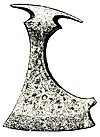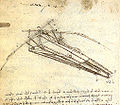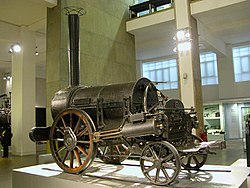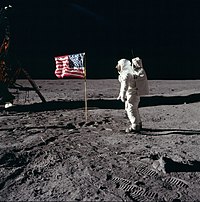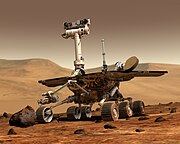History of technology
From Wikipedia, the free encyclopedia
The history of technology is the history of the invention of tools and techniques. Background knowledge has enabled people to create new things, and conversely, many scientific endeavors have become possible through technologies which assist humans to travel to places we could not otherwise go, and probe the nature of the universe in more detail than our natural senses allow.
Technological artifacts are products of an economy, a force for economic growth, and a large part of everyday life. Technological innovations affect, and are affected by, a society's cultural traditions. They also are a means to develop and project military power.
[edit] Measuring technological progress
Many sociologists and anthropologists have created social theories dealing with social and cultural evolution. Some, like Lewis H. Morgan, Leslie White, and Gerhard Lenski, declare technological progress to be the primary factor driving the development of human civilization. Morgan's concept of three major stages of social evolution (savagery, barbarism, and civilization) can be divided by technological milestones, like fire, the bow, and pottery in the savage era, domestication of animals, agriculture, and metalworking in the barbarian era and the alphabet and writing in the civilization era.
Instead of specific inventions, White decided that the measure by which to judge the evolution of culture was energy. For White "the primary function of culture" is to "harness and control energy." White differentiates between five stages of human development: In the first, people use energy of their own muscles. In the second, they use energy of domesticated animals. In the third, they use the energy of plants (agricultural revolution). In the fourth, they learn to use the energy of natural resources: coal, oil, gas. In the fifth, they harness nuclear energy. White introduced a formula P=E*T, where E is a measure of energy consumed, and T is the measure of efficiency of technical factors utilizing the energy. In his own words, "culture evolves as the amount of energy harnessed per capita per year is increased, or as the efficiency of the instrumental means of putting the energy to work is increased". Russian astronomer, Nikolai Kardashev, extrapolated his theory creating the Kardashev scale, which categorizes the energy use of advanced civilizations.
Lenski takes a more modern approach and focuses on information. The more information and knowledge (especially allowing the shaping of natural environment) a given society has, the more advanced it is. He identifies four stages of human development, based on advances in the history of communication. In the first stage, information is passed by genes. In the second, when humans gain sentience, they can learn and pass information through by experience. In the third, the humans start using signs and develop logic. In the fourth, they can create symbols, develop language and writing. Advancements in the technology of communication translates into advancements in the economic system and political system, distribution of wealth, social inequality and other spheres of social life. He also differentiates societies based on their level of technology, communication and economy: 1) hunters and gatherers, 2) simple agricultural, 3) advanced agricultural, 4) industrial 5) special (like fishing societies).
Finally, from the late 1970s sociologists and anthropologists like Alvin Toffler (author of Future Shock), Daniel Bell and John Naisbitt have approached the theories of post-industrial societies, arguing that the current era of industrial society is coming to an end, and services and information are becoming more important than industry and goods. Some of the more extreme visions of the post-industrial society, especially in fiction, are strikingly similar to the visions of near and post-Singularity societies.
[edit] By period and geography
| This section needs additional citations for verification. Please help improve this article by adding reliable references (ideally, using inline citations). Unsourced material may be challenged and removed. (May 2008) |
[edit] Early technology
- Olduvai stone technology (Olduwan) 2.5 million years ago (scrapers; to butcher dead animals)
- Acheulean stone technology 1.6 million years ago (hand axe)
- Fire used since the Paleolithic, possibly by Homo erectus as early as 1.5 Million years ago
- Clothing possibly 100,000 years ago.
- Stone tools, used by Homo floresiensis, possibly 100,000 years ago.
- Ceramics ca. 25,000 BC
- Domestication of Animals, ca. 15,000 BC
- Bow, sling ca. 9th millennium BC
- Microliths ca. 9th millennium BC
- Copper ca. 8000 BC
- Agriculture and Plough ca. 8000 BC
- Wheel ca. 4000 BC
- Gnomon ca. 4000 BC
- Writing systems ca. 3500 BC
- Bronze ca. 3300 BC
- Salt
- Chariot ca. 2000 BC
- Iron ca. 1500 BC
- Sundial ca. 800 BC
- Glass ca. 500 BC
- Catapult ca. 400 BC
- Horseshoe ca. 300 BC
- Stirrup first few centuries AD
[edit] Stone Age

During the Stone Age, all humans had a lifestyle which involved limited use of tools and few, if any, permanent settlements. The first major technologies, then, were tied to survival, hunting, and food preparation in this environment. Fire, stone tools and weapons, and clothing were technological developments of major importance during this period. Stone Age cultures developed music, and engaged in organized warfare. A subset of Stone Age people developed ocean-worthy outrigger ship technology, leading to an eastward migration across the Malay archipelago, across the Indian ocean to Madagascar and also across the Pacific Ocean, which required knowledge of the ocean currents, weather patterns, sailing, celestial navigation, and star maps. The early Stone Age is described as Epipaleolithic or Mesolithic. The former is generally used to describe the early Stone Age in areas with limited glacial impact. The later Stone Age, during which the rudiments of agricultural technology were developed, is called the Neolithic period. During this period, polished stone tools were made from a variety of hard rocks such as flint, jade, jadeite and greenstone, largely by working exposures as quarries, but later the valuable rocks were pursued by tunnelling underground, the first steps in mining technology. The polished axes were used for forest clearance and the establishment of crop farming, and were so effective as to remain in use when bronze and iron appeared.
Although Paleolithic cultures left no written records, the shift from nomadic life to settlement and agriculture can be inferred from a range of archaeological evidence. Such evidence includes ancient tools,[1] cave paintings, and other prehistoric art, such as the Venus of Willendorf. Human remains also provide direct evidence, both through the examination of bones, and the study of mummies. Though concrete evidence is limited, scientists and historians have been able to form significant inferences about the lifestyle and culture of various prehistoric peoples, and the role technology played in their lives.
[edit] Copper and Bronze Age
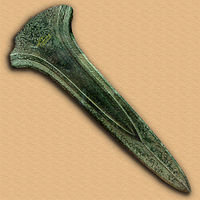
The Stone Age developed into the Bronze Age after the Neolithic Revolution. The Neolithic Revolution involved radical changes in agricultural technology which included development of agriculture, animal domestication, and the adoption of permanent settlements. These combined factors made possible the development of metal smelting, with copper and later bronze, an alloy of tin and copper, being the materials of choice, although polished stone tools continued to be used for a considerable time owing to their abundance compared with the less common metals (especially tin).
This technological trend apparently began in the Fertile Crescent, and spread outward over time. It should be noted that these developments were not, and still are not, universal. The Three-age system does not accurately describe the technology history of groups outside of Eurasia, and does not apply at all in the case of some isolated populations, such as the Spinifex People, the Sentinelese, and various Amazonian tribes, which still make use of Stone Age technology, and have not developed agricultural or metal technology.
[edit] Iron Age
The Iron Age involved the adoption of iron smelting technology. It generally replaced bronze, and made it possible to produce tools which were stronger and cheaper to make than bronze equivalents. In many Eurasian cultures, the Iron Age was the last major step before the development of written language, though again this was not universally the case. It was not possible to mass manufacture steel because high furnace temperatures were needed, but steel could be produced by forging bloomery iron to reduce the carbon content in a controllable way. Iron ores were much more widespread than either copper or tin. In Europe, large hill forts were built either as a refuge in time of war, or sometimes as permanent settlements. In some cases, existing forts from the Bronze Age were expanded and enlarged. The pace of land clearance using the more effective iron axes increased, providing more farmland to support the growing population.
By 1000 BC - 500 BC, the Germanic tribes had a Bronze Age civilization, while the Celts were in the Iron Age by the time of the Hallstatt culture. Their cultures collided with the military and agricultural practices of the Romans, leading those Europeans who were conquered to adopt Roman technological advances.
[edit] Ancient civilizations
It was the growth of the ancient civilizations which produced the greatest advances in technology and engineering, advances which stimulated other societies to adopt new ways of living and governance.
The Egyptians invented and used many simple machines, such as the ramp to aid construction processes. The Indus Valley Civilization, situated in a resource-rich area, is notable for its early application of city planning and sanitation technologies. Ancient India was also at the forefront of seafaring technology - a panel found at Mohenjodaro, depicts a sailing craft. Indian construction and architecture, called 'Vaastu Shastra', suggests a thorough understanding of materials engineering, hydrology, and sanitation.
The Chinese made many first-known discoveries and developments. Major technological contributions from China include early seismological detectors, matches, paper, sliding calipers, the double-action piston pump, cast iron, the iron plough, the multi-tube seed drill, the wheelbarrow, the suspension bridge, the parachute, natural gas as fuel, the magnetic compass, the raised-relief map, the propeller, the crossbow, the South Pointing Chariot, and gun powder.

Greek and Hellenistic engineers invented many technologies and improved upon pre-existing technologies, particularly during the Hellenistic period. The Romans developed an intensive and sophisticated agriculture, expanded upon existing iron working technology, created laws providing for individual ownership, advanced stone masonry technology, advanced road-building (exceeded only in the 19th century), military engineering, civil engineering, spinning and weaving and several different machines like the Gallic reaper that helped to increase productivity in many sectors of the Roman economy. Roman engineers were the first to build monumental arches, amphitheatres, aqueducts, public baths, true arch bridges, harbours, reservoirs and dams, vaults and domes on a very large scale across their Empire. Notable Roman inventions include the book (Codex), glass blowing and concrete. Because Rome was located on a volcanic peninsula, with sand which contained suitable crystalline grains, the concrete which the Romans formulated was especially durable. Some of their buildings have lasted 2000 years, to the present day.
The engineering skills of the Inca and the Mayans were great, even by today's standards. An example is the use of pieces weighing in upwards of one ton in their stonework placed together so that not even a blade can fit in-between the cracks. The villages used irrigation canals and drainage systems, making agriculture very efficient. While some claim that the Incas were the first inventors of hydroponics, their agricultural technology was still soil based, if advanced. Though the Maya civilization had no metallurgy or wheel technology, they developed complex writing and astrological systems, and created sculptural works in stone and flint. Like the Inca, the Maya also had command of fairly advanced agricultural and construction technology. Throughout this time period much of this construction, was made only by women, as men of the Maya civilization believed that females were responsible for the creation of new things. The main contribution of the Aztec rule was a system of communications between the conquered cities. In Mesoamerica, without draft animals for transport (nor, as a result, wheeled vehicles), the roads were designed for travel on foot, just like the Inca and Mayan civilizations.
[edit] Medieval and Modern technologies
[edit] Medieval Europe

European technology in the Middle Ages may be best described as a symbiosis of traditio et innovatio. While medieval technology has been long depicted as a step backwards in the evolution of Western technology, sometimes willfully so by modern authors intent on denouncing the church as antagonistic to scientific progress (see e.g. Myth of the Flat Earth), a generation of medievalists around the American historian of science Lynn White stressed from the 1940s onwards the innovative character of many medieval techniques. Genuine medieval contributions include for example mechanical clocks, spectacles and vertical windmills. Medieval ingenuity was also displayed in the invention of seemingly inconspicuous items like the watermark or the functional button. In navigation, the foundation to the subsequent age of exploration was laid by the introduction of pintle-and-gudgeon rudders, lateen sails, the dry compass the horseshoe and the astrolab.
Significant advances were also made in military technology with the development of plate armour, steel crossbows, counterweight trebuchets and cannon. Perhaps best known are the Middle Ages for their architectural heritage: While the invention of the rib vault and pointed arch gave rise to the high rising Gothic style, the ubiquitous medieval fortifications gave the era the almost proverbial title of the 'age of castles'.
[edit] Muslim Agricultural Revolution
From the 8th century, the medieval Islamic world witnessed a fundamental transformation in agriculture known as the "Muslim Agricultural Revolution", "Arab Agricultural Revolution", or "Green Revolution".[2] Due to the global economy established by Muslim traders across the Old World during the "Afro-Asiatic age of discovery" or "Pax Islamica", this enabled the diffusion of many crops, plants and farming techniques between different parts of the Islamic world, as well as the adaptation of crops, plants and techniques from beyond the Islamic world, distributed throughout Islamic lands which normally would not be able to grow these crops.[3] Some have referred to the diffusion of numerous crops during this period as the "Globalisation of Crops",[4] which, along with an increased mechanization of agriculture, led to major changes in economy, population distribution, vegetation cover,[5] agricultural production and income, population levels, urban growth, the distribution of the labour force, linked industries, cooking and diet, clothing, and numerous other aspects of life in the Islamic world.[3]
Muslim engineers in the Islamic world were responsible for numerous innovative industrial uses of hydropower, the early industrial uses of tidal power, wind power, and petroleum, and large factory complexes (tiraz in Arabic).[6] The industrial uses of watermills were in widespread use since the 8th century. A variety of industrial mills were developed in the Islamic world, including fulling mills, gristmills, hullers, paper mills, sawmills, shipmills, stamp mills, steel mills, sugar mills, tide mills, and windmills. By the 11th century, every province throughout the Islamic world had these industrial mills in operation, from al-Andalus and North Africa to the Middle East and Central Asia.[7] Muslim engineers also developed crankshafts and water turbines.[8]
A significant number of inventions were produced by Muslim scientists and engineers during this time, including inventors such as Abbas Ibn Firnas, Taqi al-Din, and especially al-Jazari, who is considered the "father of robotics"[9] and "father of modern day engineering".[10] Some of the developments from the Islamic Golden Age include the camera obscura, coffee, hang glider, hard soap, shampoo, nitric acid, alembic, valve, reciprocating, combination lock, quilting, pointed arch, surgical catgut, windmill, inoculation, fountain pen, cryptanalysis, frequency analysis, quartz glass, Persian carpet, modern cheque, celestial globe, explosive rockets and incendiary devices.[9]
[edit] Renaissance
|
The era is marked by such profound technical advancements like the printing press, linear perspectivity, patent law, double shell domes or Bastion fortresses. Note books of the Renaissance artist-engineers such as Taccola and Leonardo da Vinci give a deep insight into the mechanical technology then known and applied. Architects and engineers were inspired by the structures of Ancient Rome, and men like Brunelleschi created the large dome of Florence Cathedral as a result. He was awarded one of the first patents ever issued in order to protect an ingenious crane he designed to raise the large masonry stones to the top of the structure. Military technology developed rapidly with the widespread use of the cross-bow and ever more powerful artillery, as the city-states of Italy were usually in conflict with one another. Powerful families like the Medici were strong patrons of the arts and sciences.
[edit] Age of Exploration
The sailing ship (Nau or Carrack) enabled the Age of Exploration with the European colonization of the Americas, epitomized by Francis Bacon's The New Atlantis. Pioneers like Vasco de Gama, Cabral, Magellan and Christopher Columbus explored the world in search of new trade routes for their goods and contacts with Africa, India and China which shortened the journey compared with traditional routes overland. They also re-discovered the Americas while doing so. They produced new maps and charts which enabled following mariners to explore further with greater confidence. Navigation was generally difficult however owing to the problem of longitude and the absence of accurate chronometers. European powers rediscovered the idea of the Civil code, lost since the time of the Ancient Greeks.
[edit] Industrial Revolution
|
|
The British Industrial Revolution is characterized by developments in the areas of textile manufacturing, mining, metallurgy and transport driven by the development of the steam engine. Above all else, the revolution was driven by cheap energy in the form of coal, produced in ever-increasing amounts from the abundant resources of Britain. Coal converted to coke gave the blast furnace and cast iron in much larger amounts than before, and a range of structures could be created, such as The Iron Bridge. Cheap coal meant that industry was no longer constrained by water resources driving the mills, although it continued as a valuable source of power. The steam engine helped drain the mines, so more coal reserves could be accessed, and the output of coal increased. The development of the high-pressure steam engine made locomotives possible, and a transport revolution followed.
[edit] 19th century
The 19th century saw astonishing developments in transportation, construction, and communication technologies originating in Europe, especially in Britain. The Steam Engine which had existed since the early 18th century, was practically applied to both steamboat and railway transportation. The first purpose built railway line opened between Manchester and Liverpool in 1830, the Rocket locomotive of Robert Stephenson being one of the first working locomotives used on the line. Telegraphy also developed into a practical technology in the 19th century to help run the railways safely.
Other technologies were explored for the first time, including the Incandescent light bulb. The Portsmouth Block Mills was where manufacture of ships' pulley blocks by all-metal machines first took place and instigated the age of mass production. Machine tools used by engineers to manufacture other machines began in the first decade of the century, notably by Richard Roberts and Joseph Whitworth. Steamships were eventually completely iron-clad, and played a role in the opening of Japan and China to trade with the West. Mechanical computing was envisioned by Charles Babbage but did not come to fruition. The Second Industrial Revolution at the end of the 19th century saw rapid development of chemical, electrical, petroleum, and steel technologies connected with highly structured technology research.
[edit] 20th century
20th Century technology developed rapidly. Communication technology, transportation technology, broad teaching and implementation of Scientific method, and increased research spending all contributed to the advancement of modern science and technology. Due to the scientific gains directly tied to military research and development, technologies including electronic computing might have developed as rapidly as they did in part due to war. Radio, radar, and early sound recording were key technologies which paved the way for the telephone, fax machine, and magnetic storage of data. Energy and engine technology improvements were also vast, including nuclear power, developed after the Manhattan project. Transport by rocketry: most work occurred in the U.S. (Goddard), Russia (Tsiolkovsky) and Germany (Oberth). Making use of computers and advanced research labs, modern scientists have Recombinant DNA.
The National Academy of Engineering, by expert vote, established the following ranking of the most important technological developments of the 20th century [1]:
- 1. Electrification
- 2. Automobile
- 3. Airplane
- 4. Water supply and Distribution
- 5. Electronics
- 6. Radio and Television
- 7. Mechanised agriculture
- 8. Computers
- 9. Telephone
- 10. Air Conditioning and Refrigeration
- 11. Highways
- 12. Spacecraft
- 13. Internet
- 14. Imaging
- 15. Household appliances
- 16. Health Technologies
- 17. Petroleum and Petrochemical Technologies
- 18. Laser and Fiber Optics
- 19. Nuclear technologies
- 20. Materials science
- 21. Petroleum technologies
[edit] 21st century
Despite the fact that humans have just entered the 21st century, technology is being developed even more rapidly, marked progress in almost all fields of science and technology has led to massive improvements to the technology we currently possess, the rate of development in computers being only one example at which the speed of progress continues forward, leading to the speculation of a technological singularity occurring within this century. After the physical barriers of the integrated circuit are reached, quantum computers might be introduced. This could pave the way to the simulation of biological brains and/or the storage thereof.
Current ongoing developments include research into nanotechnology, bioengineering, nuclear fusion (see ITER and DEMO), advanced materials (e.g., enhanced armor), alternative fuel technologies (e.g., fuel cells, plugin hybrid cars), the scramjet (along with railguns and high-energy beams for military uses), superconductivity, the memristor and a plethora of other fields.
In electronics, researchers are trying to improve the efficiencies of LEDs and solar cells.
The understanding of particle physics is also expected to expand through particle accelerator projects, such as the LHC - the largest science project in the world [11] and neutrino detectors such as the ANTARES. Theoretical physics currently investigates quantum gravity proposals such as M-theory, superstring theory, and loop quantum gravity.
Spacecraft designs are also being developed, i.a. under the Project Constellation (see Orion and Ares V). The James Webb Space Telescope will try to identify early galaxies as well as the exact location of the Solar System within our galaxy, using the infrared spectrum. The finished International Space Station will provide an intermediate platform for space missions and zero gravity experiments. Despite challenges and criticism, the NASA and ESA plan a manned mission to Mars in the 2030s. The concept of connecting your home computer to your music library to your mobile phone is no longer as exotic as it was a few years ago. These days just about everyone with high-speed Internet, or broadband, service has some sort of home network set up.
[edit] By type of technology
[edit] History of biotechnology
| This section requires expansion. |
To be incorporated into main article:
- Timeline of agriculture and food technology
- Hunter-gatherer
- Agriculture
- Food science
- Genetically modified food
- History of agricultural science
- History of gardening
- Biotechnology (timeline, etc.)
- History of sushi
- History of tea in China
- History of Early Man Technology
[edit] History of civil engineering
| This section requires expansion. |
To be incorporated:
- Civil engineering
- Architecture and building construction
- Bridges, harbors, tunnels, dams
- Surveying, instruments and maps, cartography, urban engineering, water supply and sewerage
[edit] History of communication
| This section requires expansion. |
To be incorporated:
- Communications
- Writing systems
- Telecommunications
- History of mobile phones
- History of animation
- History of broadcasting
- History of radar
- History of radio
- Printing
- Cinema
- Radio
- Television
- Internet
[edit] History of computing
- History of computing hardware before 1960
- History of computing hardware (1960s–present)
- History of computer hardware in Soviet Bloc countries
- History of computer science
- History of operating systems
- History of software engineering
- History of programming languages
- History of artificial intelligence
- History of the graphical user interface
- History of the Internet
- History of the World Wide Web
- History of computer and video games
[edit] History of consumer technology
| This section requires expansion. |
To be incorporated:
- Timeline of lighting technology
- History of textiles and clothing
- History of materials science
- Family and consumer science
- History of knitting
- History of lensmaking
- History of the chair
- History of the umbrella
- Manufacturing
[edit] History of electrical engineering
| This section requires expansion. |
To be incorporated:
[edit] History of energy technology
| This section requires expansion. |
To be incorporated:
- Energy (History, Use by humans, See also)
- History of coal mining
- History of perpetual motion machines
- Timeline of steam power
- Timeline of hydrogen technologies
- Timeline of alcohol fuel
- Timeline of nuclear fusion
[edit] History of materials science
| This section requires expansion. |
To be incorporated:
- Timeline of materials technology
- Metallurgy
- Materials and processing
[edit] History of measurement
| This section requires expansion. |
To be incorporated:
[edit] History of medicine
| This section requires expansion. |
[edit] History of military technology
| This section requires expansion. |
To be incorporated into main article:
-
- Military history#Technological Evolution
- Category:Military history - articles on history of specific technologies
[edit] History of nuclear technology
[edit] History of science and technology
| This section requires expansion. |
- History of telescopes
- Timeline of telescopes, observatories, and observing technology
- Timeline of microscope technology
- Timeline of particle physics technology
- Timeline of low-temperature technology
- Timeline of temperature and pressure measurement technology
[edit] History of transport technology
| This section requires expansion. |
To be incorporated into main article:
- Timeline of motor and engine technology
- Timeline of photography technology
- Timeline of rocket and missile technology
- Timeline of communication technology
[edit] See also
[edit] Related history
[edit] Related disciplines
- Timeline of invention
- List of independent discoveries
- Critique of technology
- Technical education
- Philosophy of technology
- History of science and technology (field of study)
- History of ideas (field of study)
- Technology Dynamics (field of study)
- Technology
- Engineering
- Science and technology in Canada
[edit] Related subjects
[edit] Future of science and technology (speculative)
Main Page on Future , a Wikia wiki
[edit] People
- List of engineers and list of inventors
- Biography of inventors and explorers
- Technical societies
- Technocracy
- Technology and society
[edit] Historiography of science and technology
[edit] Historians of science and technology
- Johann Beckmann
- I. Bernard Cohen
- Ruth Schwartz Cowan
- John L. Heilbron
- Thomas P. Hughes
- Daniel Kevles
- Melvin Kranzberg
- Thomas Kuhn
- Dylan Stiddle
- Lewis Mumford
- Joseph Needham
- Abraham Pais
- George Sarton
- Charles Singer
- W. Patrick McCray
- W. David Lewis
- Silvio A. Bedini
- Paul Josephson
[edit] Journals and periodicals in the history of science and technology
- History of Technology
- ICON
- Technology and Culture
- Transactions of the Newcomen Society
- Bill Frank
[edit] Research institutes
[edit] Notes
- ^ http://news.nationalgeographic.com/news/2004/01/0114_040114_siberianhumans.html
- ^ Thomas F. Glick (1977), "Noria Pots in Spain", Technology and Culture 18 (4), p. 644-650.
- ^ a b Andrew M. Watson (1974), "The Arab Agricultural Revolution and Its Diffusion, 700-1100", The Journal of Economic History 34 (1), p. 8-35.
- ^ The Globalisation of Crops, FSTC
- ^ Andrew M. Watson (1983), Agricultural Innovation in the Early Islamic World, Cambridge University Press, ISBN 052124711X.
- ^ Maya Shatzmiller, p. 36.
- ^ Adam Robert Lucas (2005), "Industrial Milling in the Ancient and Medieval Worlds: A Survey of the Evidence for an Industrial Revolution in Medieval Europe", Technology and Culture 46 (1), p. 1-30 [10].
- ^ Donald Routledge Hill, "Mechanical Engineering in the Medieval Near East", Scientific American, May 1991, p. 64-69. (cf. Donald Routledge Hill, Mechanical Engineering)
- ^ a b Paul Vallely, How Islamic Inventors Changed the World, The Independent, 11 March 2006.
- ^ 1000 Years of Knowledge Rediscovered at Ibn Battuta Mall, MTE Studios.
- ^ DiscoveryChannel.ca - Colossal construction: The world's nine largest science projects
[edit] References
- Singer, C., Holmyard, E.J., Hall, A. R and Williams, T. I. (eds.), (1954-59 and 1978) A History of Technology,, 7 vols., Oxford, Clarendon Press,. (Vols 6 and 7, 1978, ed. T. I. Williams)
- Kranzberg, Melvin and Pursell, Carroll W. Jr., eds. (1967)Technology in Western Civilization: Technology in the Twentieth Century New York: Oxford University Press.
- Pacey, Arnold, (1974, 2ed 1994),The Maze of Ingenuity The MIT Press, Cambridge, Mass, 1974, [2ed 1994, cited here]
- Derry, Thomas Kingston and Williams, Trevor I., (1993) A Short History of Technology: From the Earliest Times to A.D. 1900. New York: Dover Publications.
- Brush, S. G. (1988). The History of Modern Science: A Guide to the Second Scientific Revolution 1800-1950. Ames: Iowa State University Press.
- Bunch, Bryan and Hellemans, Alexander, (1993) The Timetables of Technology, New York, Simon and Schuster.
- Greenwood, Jeremy (1997) The Third Industrial Revolution: Technology, Productivity and Income Inequality AEI Press.
- Landa, Manuel de, War in the Age of Intelligent Machines, 2001.
- Olby, R. C. et al., eds. (1996). Companion to the History of Modern Science,. New York, Routledge.
[edit] External links
- http://www.mpoweruk.com/history.htm Electropaedia on the History of Technology]
- http://www.fptt-pftt.gc.ca/success/century/1900_e.shtml This is a very good site for looking at Technology in the 1900s (20th century)
- MIT 6.933J - The Structure of Engineering Revolutions. From MIT OpenCourseWare, course materials (graduate level) for a course on the history of technology through a Thomas Kuhn-ian lens.
- Concept of Civilization Events. From Jaroslaw Kessler, a chronology of "civilizing events".
- Ancient and Medieval City Technology


